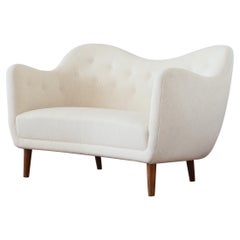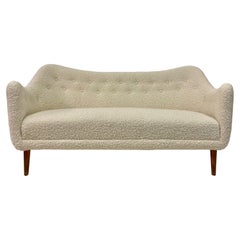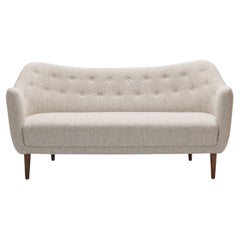Bovirke Sofas
to
1
2
1
3
Height
to
Width
to
Depth
to
3
2
1
3
3
2
3
3
3
2
1
3
3
3
3
3
3
13
425
294
178
159
Creator: Bovirke
Original Finn Juhl BO46 Sofa for Bovirke, 1946
By Bovirke, Finn Juhl
Located in Copenhagen, DK
Finn Juhl BO46 sofa upholstered with off-white fabric, tapering legs of stained beech.
Designed by Finn Juhl, 1946 and manufactured by Bovirke, Denm...
Category
1940s Danish Scandinavian Modern Vintage Bovirke Sofas
Materials
Fabric, Beech
Rare Finn Juhl Bovirke BO64 Sofa in Fine Belgian Two-Toned Boucle
By Bovirke, Finn Juhl
Located in Culver City, CA
A prized piece for any Danish modern enthusiast, this Finn Juhl for Bovirke BO64 3 seater sofa is absolutely stunning. Designed in the late 1940's this piece still has its original straps and hand tied springs (repaired and reinforced on the bottom by our restoration specialists).
This sofa has been reupholstered in a luxurious creamy white Belgian boucle...
Category
1940s Danish Mid-Century Modern Vintage Bovirke Sofas
Materials
Bouclé, Beech
$25,600 Sale Price
20% Off
Rare three-seater sofa in grey textile by Finn Juhl
By Finn Juhl, Bovirke
Located in Copenhagen, DK
BO 77 - 3-seater sofa in new grey textile (Ecriture from Kvadrat, colours 270/210) with oxidised steel frame and teak shoes. Designed in 1953. Designed by Finn Juhl for Bovirke.
Category
Mid-20th Century Danish Mid-Century Modern Bovirke Sofas
Materials
Steel
Related Items
Finn Juhl Jupiter Sofa France and Son Denmark 1965 Black
By France & Søn, Finn Juhl
Located in Roosendaal, Noord Brabant
Danish modern so called Jupiter sofa model 218 designed by Finn Juhl and manufactured by France and Son, Denmark 1965. The sofa has a solid rosewood frame...
Category
1960s Danish Scandinavian Modern Vintage Bovirke Sofas
Materials
Leather, Rosewood
2011 Minotti Williams Three Seat Sofa by Rodolfo Dordoni in Grey Fabric
By Minotti, Rodolfo Dordoni
Located in Philadelphia, PA
This is a large three-seater Williams sofa, initially designed by Rodolfo Dordoni for Minotti in 2009. This example dates to 2011. Its design consists of a solid stainless-steel fram...
Category
2010s Italian Modern Bovirke Sofas
Materials
Steel
$10,000
H 32 in W 101 in D 40 in
BO 101 - rare bench in Rio rosewood by Finn Juhl
By Bovirke, Finn Juhl
Located in Copenhagen, DK
BO 101 - rare bench in Rio rosewood with brass details and anodised steel legs. Designed by Finn Juhl in 1947 and made by Bovirke.
Category
Mid-20th Century Danish Mid-Century Modern Bovirke Sofas
Materials
Brass, Steel
Finn Juhl BO46 sofa For Bovirke
By Finn Juhl
Located in Shibuya-ku, 13
Along with Wegner and Jacobsen, Finn Juhl is one of the most famous Danish furniture designers. The appeal of his works is said to be their sculptural curves and the beauty of their ...
Category
1940s Danish Scandinavian Modern Vintage Bovirke Sofas
Materials
Fabric, Oak
Rare Lou Hodges Three Seat Sling Sofa
By Lou Hodges
Located in Los Angeles, CA
This incredibly rare and iconic 70's Sling sofa by Lou Hodges for California Design Group has been restored and is in beautiful condition.
Both the cantilevered Oak frame and leath...
Category
1970s American Mid-Century Modern Vintage Bovirke Sofas
Materials
Leather, Oak
Finn Juhl, Rare Important Sofa Walnut Fabric, Baker Furniture United States 1951
By Baker Furniture Company, Finn Juhl
Located in High Point, NC
A rare and important sofa, designed by Finn Juhl in 1951 for Baker Furniture Company, Michigan.
Introduced to the American design community by Edgar Kaufmann Jr, an art collector...
Category
1950s American Mid-Century Modern Vintage Bovirke Sofas
Materials
Fabric, Walnut
$95,000
H 40 in W 75 in D 28 in
Contemporary Three-Seater Sofa by Hessentia Upholstered in Grey Bouclé Fabric
By Cornelio Cappellini, HESSENTIA
Located in Carate, Brianza (MB)
Gio sofa is the result of a long design process and a synergistic collaboration between the architect Luca Erba and company Cornelio Cappellini. This sofa amazes for its soft and def...
Category
2010s Italian Modern Bovirke Sofas
Materials
Fabric, Bouclé
$17,094 / item
H 27.56 in W 118.12 in D 40.16 in
Jupiter Sofa by Finn Juhl for from France and Søn and France & Daverkosen
By Finn Juhl
Located in Leuven, Vlaams Gewest
Danish modern so called Jupiter sofa model 218 designed by Finn Juhl and manufactured by France and Son.
The sofa has a solid rosewood frame and black leather seating. The sofa is ...
Category
1960s Danish Mid-Century Modern Vintage Bovirke Sofas
Materials
Leather, Rosewood
$6,242
H 31.5 in W 78.75 in D 31.5 in
Finn Juhl Rare Early Baker Sofa
By Finn Juhl, Onecollection
Located in Dronten, NL
A rare and important sofa, designed by Finn Juhl in 1951 for Baker Furniture Company, Michigan.
Introduced to the American design community by Edgar Kaufmann Jr, an art collector an...
Category
Late 20th Century Danish Scandinavian Modern Bovirke Sofas
Materials
Fabric, Teak
Finn Juhl Fireplace chair
By Bovirke, Finn Juhl
Located in Copenhagen, DK
Finn Juhl 'Fireplace' chair designed 1946 and executed at cabinetmaker Bovirke, Denmark.
Frame of teak, new upholstery in light fabric by Tove Kindt-Larsen. Very fine condition.
Category
1940s Danish Scandinavian Modern Vintage Bovirke Sofas
Materials
Fabric, Teak
Finn Juhl Sofa BO 46 Bovirke
By Finn Juhl
Located in Pawtucket, RI
The perfect Finn Juhl settee manufactured by Bovirke in 1946. Reupholstered with new Hallingdal fabric. Iconic Danish design in perfect restored condition.
Category
1940s Danish Scandinavian Modern Vintage Bovirke Sofas
Materials
Wool
Danish Modern Finn Juhl Sheepskin BO46 sofa, 1946
By Finn Juhl
Located in Uccle, BE
Sofa model BO46 by Finn Juhl for Bovirke, made in Denmark in 1946. Round beech legs. Reupholstered in sheepkin. Leather buttons. Excellent vintage condition.
Early and important Finn...
Category
Mid-20th Century Danish Scandinavian Modern Bovirke Sofas
Materials
Sheepskin, Beech
Previously Available Items
Mid Century Danish BO64 Sofa by Finn Juhl in Boucle
By Bovirke, Finn Juhl
Located in London, London
BO64 sofa
By Finn Juhl for Bovirke
Restored and newly upholstered in Designers Guild Boucle
Beech frame
Buttoned back and sides
Seat height 42cm
Mid Century Denmark.
Category
Mid-20th Century Danish Mid-Century Modern Bovirke Sofas
Materials
Bouclé, Beech
Rare Finn Juhl BO64 3-Seater Sofa by Bovirke 1946, Fully Restored
By Finn Juhl, Bovirke
Located in Utrecht, NL
Extremely rare BO64 sofa designed in 1946/48 by Finn Juhl, executed by Bovirke, Copenhagen Denmark.
Frame of solid beech, stained dark with a fully hand sewn upholstery of the fi...
Category
1940s Danish Scandinavian Modern Vintage Bovirke Sofas
Materials
Fabric, Wool, Linen, Beech
Mid Century Danish BO64 Sofa by Finn Juhl in Boucle
By Finn Juhl, Bovirke
Located in London, London
BO64 sofa
By Finn Juhl for Bovirke
Restored and newly upholstered in Designers Guild Boucle
Beech frame
Buttoned back and sides
Seat height 42cm
...
Category
Mid-20th Century Danish Mid-Century Modern Bovirke Sofas
Materials
Bouclé, Beech
Pair of Finn Juhl Bo 46 Sofas by Carl Brørup for Bovirke, 1946
By Finn Juhl, Bovirke
Located in Copenhagen, DK
FINN JUHL BY CARL BRØRUP FOR BOVIRKE, SCANDINAVIAN MODERN
An beautiful pair of Finn Juhl two-seat BO46 sofas, designed in 1946, manufactured by Carl Brør...
Category
Mid-20th Century Danish Mid-Century Modern Bovirke Sofas
Materials
Fabric, Beech
Original Finn Juhl BO 46 Sofa by Carl Brørup for Bovirke, 1946
By Finn Juhl, Bovirke
Located in Copenhagen, DK
Finn Juhl & CARL BRØRUP FOR Bovirke, Scandinavian Modern
An beautiful Finn Juhl two-seat BO46 sofa, designed in 1946, manufactured by Carl Brørup for Bov...
Category
Mid-20th Century Danish Mid-Century Modern Bovirke Sofas
Materials
Fabric, Beech
Finn Juhl Sofa Model BO55 by Bovirke in Denmark
By Finn Juhl, Bovirke
Located in Esbjerg, DK
Rare sofa model BO55 designed by Finn Juhl. Produced by Bovirke in Denmark.
Legs of teak, upholstery of Hallingdal by Kvadrat.
Category
1940s Danish Scandinavian Modern Vintage Bovirke Sofas
Materials
Wool, Teak
2-Seat Sofa by Finn Juhl
By Finn Juhl, Bovirke
Located in Copenhagen, DK
BO 46, 2-seat sofa reupholstered with Sunniva wool from Kvadrat with legs in beech. Designed 1946. Maker Bovirke.
Category
Mid-20th Century Danish Scandinavian Modern Bovirke Sofas
Materials
Beech
Midcentury "Poet" Sofa by Finn Juhl Upholstered in Boucle
By Finn Juhl, Bovirke
Located in Lejre, DK
Original "Poet" sofa designed by Maa. Finn Juhl for Bovirke in the 1940s. Made in Denmark. Upholstered in two tones French bouclé. Great condition.
Category
1940s Danish Scandinavian Modern Vintage Bovirke Sofas
Materials
Bouclé
BO 46 by Finn Juhl
By Bovirke
Located in Copenhagen, DK
BO 46 - Reupholstered 2-seat sofa in Hallingdal col. 407 & 457, legs in lacquered beech. Designed in 1946. Maker Bovirke.
Category
Mid-20th Century Danish Scandinavian Modern Bovirke Sofas
Finn Juhl BO46 sofa for Bovirke, 1946
By Finn Juhl, Bovirke
Located in Copenhagen, DK
Finn Juhl sofa, designed 1946 and manufactured by Bovirke, Denmark, model BO46.
Fabric upholstery and tapering legs of stained wood.
Category
1940s Danish Scandinavian Modern Vintage Bovirke Sofas
Materials
Fabric, Teak
Finn Juhl Poet Sofa
By Finn Juhl, Bovirke
Located in London, GB
An early example of the "Poet" sofa designed by Finn Juhl in 1946 and produced by cabinetmakers Bovirke in the 1950s.
The essentialness of the lines in this piece result in a shape ...
Category
1940s Danish Mid-Century Modern Vintage Bovirke Sofas
Materials
Wool, Beech
Finn Juhl BO64 Sofa for Bovirke, 1948
By Finn Juhl, Bovirke
Located in Copenhagen, DK
Finn Juhl 2.5 - 3 person sofa upholstered with off white wool, tapering legs of stained beech.
Designed by Finn Juhl 1948 and manufactured by Bovirke Denmark, model BO64...
Category
1940s Danish Scandinavian Modern Vintage Bovirke Sofas
Materials
Wool
Bovirke sofas for sale on 1stDibs.
Bovirke sofas are available for sale on 1stDibs. These distinctive items are frequently made of wood and are designed with extraordinary care. There are many options to choose from in our collection of Bovirke sofas, although brown editions of this piece are particularly popular. Many of the original sofas by Bovirke were created in the mid-century modern style in scandinavia during the mid-20th century. If you’re looking for additional options, many customers also consider sofas by Svend Skipper, Aksel Bender Madsen, and Komfort. Prices for Bovirke sofas can differ depending upon size, time period and other attributes — on 1stDibs, these items begin at $17,686 and can go as high as $25,600, while a piece like these, on average, fetch $20,702.






